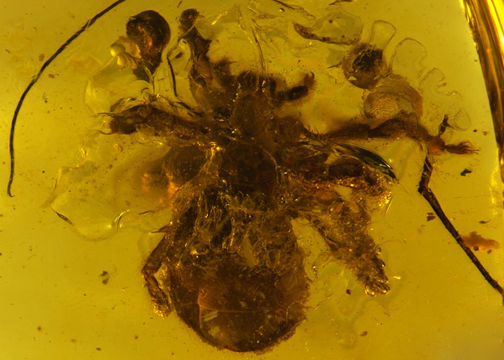Abstract
Ricinulei Thorell, 1876 is an order of Arachnida currently represented in the New and Old Worlds by 103 living species. The order is also represented in the fossil record from the Carboniferous (ca. 305–319 Ma) and the Cretaceous (ca. 99 Ma) periods. In the present contribution, Hirsutisoma grimaldii sp. nov., a new extinct species of the suborder Primoricinulei Wunderlich, 2015, is described from a specimen preserved in Cretaceous Burmese amber. The specimen is a well-preserved adult male in which several taxonomically informative structures are visible, allowing the new species to be differentiated from Hirsutisoma bruckschi Wunderlich, 2017, the only other congener for which a male is known. This description raises the number of Cretaceous Ricinulei species to six. A comparative table documents morphological differences among the various species of this lineage. Hypotheses concerning the paleoecology and functional morphology of this species and, by extrapolation, other primoricinuleids, are presented. The evidence suggests that Primoricinulei were corticolous, scansorial predators.
References
- Benavides, L.R., Daniels, S.R. & Giribet, G. (2021) Understanding the real magnitude of the arachnid order Ricinulei through deep Sanger sequencing across its distribution range and phylogenomics, with the formalization of the first species from the Lesser Antilles. Journal of Zoological Systematics and Evolutionary Research, 59 (8), 1850–1873. https://doi.org/10.1111/jzs.12546
- Botero-Trujillo, R. & Flórez, E. (2017) Two new ricinuleid species from Ecuador and Colombia belonging to the peckorum species-group of Cryptocellus Westwood (Arachnida, Ricinulei). Zootaxa, 4286 (4), 483–498. https://doi.org/10.11646/zootaxa.4286.4.2
- Botero-Trujillo, R., Carvalho, L.S., Flórez D., E. & Prendini, L. (2021a) Four new species of “hooded tick-spiders” (Ricinulei, Ricinoididae) from South and Central America, with clarification of the identity of Cryptocellus leleupi Cooreman, 1976. American Museum Novitates, 3976, 1–35. https://doi.org/10.1206/3976.1
- Botero-Trujillo, R., Sain, C.E. & Prendini, L. (2021b) Systematics of the “giant” Ricinulei (Ricinoididae: Ricinoides) of West Africa, with descriptions of five new species and comparative morphology of the male copulatory apparatus. Bulletin of the American Museum of Natural History, 448, 1–68. https://doi.org/10.1206/0003-0090.448.1.1
- Dunlop, J.A., Penney, D. & Jekel, D. (2020) A summary list of fossil spiders and their relatives. In: World spider catalog, version 20.5. Natural History Museum Bern. Available from: https://wsc.nmbe.ch/resources/fossils/Fossils20.5.pdf (accessed May 30, 2022)
- Fedorov, A, Beichel, R., Kalpathy-Cramer, J., Finet, J., Fillion-Robin. J.-C., Pujol, S., Bauer, C., Jennings, D., Fennessy, F., Sonka, M., Buatti, J., Aylward, S., Miller, J.V., Pieper, S. & Kikinis, R. (2012) 3D slicer as an image computing platform for the quantitative imaging network. Magnetic Resonance Imaging, 30 (9), 1323–1341.
- Harvey, M.S. (2003) Catalogue of the smaller arachnid orders of the world. CSIRO Publishing, Collingwood, Victoria, Australia, 385 pp. https://doi.org/10.1071/9780643090071
- Platnick, N.I. (2002) Ricinulei. In: Adis, J. (Ed.), Amazonian Arachnida and Myriapoda. Pensoft Publishers, Sofia-Moscow, pp. 381–386.
- Prendini, L. (2011) Order Ricinulei Thorell, 1876. In: Zhang, Z.Q. (Ed.), Animal biodiversity: An outline of higher-level classification and survey of taxonomic richness. Zootaxa, 3148, 122. https://doi.org/10.11646/zootaxa.3148.1.22
- Ross, A.J. (2019) Burmese (Myanmar) amber checklist and bibliography 2018. Palaeoentomology, 2 (1), 22–84. https://doi.org/10.11646/palaeoentomology.2.1.5
- Selden, P.A. (1992) Revision of the fossil ricinuleids. Transactions of the Royal Society of Edinburgh: Earth Sciences, 83, 595–634. https://doi.org/10.1017/S0263593300003333
- Selden, P.A. & Ren, D. (2017) A review of Burmese amber arachnids. Journal of Arachnology, 45, 324–343.
- Thorell, T. (1876) Sopra alcuni Opilioni (Phalangidea) d’Europa e dell’Asia Occidentale. Annali del Museo Civico di Storia Naturale di Genova, 8, 452–508. https://doi.org/10.5962/bhl.part.10418
- Valdez-Mondragón, A. & Cortez-Roldán, M.R. (2021) COI mtDNA barcoding and morphology for the description of a new species of ricinuleid of the genus Pseudocellus (Arachnida: Ricinulei: Ricinoididae) from El Triunfo Biosphere Reserve, Chiapas, Mexico. European Journal of Taxonomy, 778, 1–25. https://doi.org/10.5852/ejt.2021.778.1563
- Valdez-Mondragón, A. & Francke, O.F. (2017) Ricinúlidos de México, un grupo de arácnidos diverso y aún poco conocido en el país. Boletín de la Asociación Mexicana de Sistemática de Artrópodos, 1, 11–17.
- Valdez-Mondragón, A. & Juárez-Sánchez, A.R. (2021) A new epigean species of ricinuleid of the genus Pseudocellus (Arachnida: Ricinulei: Ricinoididae) from a tropical sub-deciduous forest in Oaxaca, Mexico. Journal of Arachnology, 48, 329–338. https://doi.org/10.1636/JoA-S-20-014
- Valdez-Mondragón, A., Francke, O.F. & Botero-Trujillo, R. (2018) New morphological data for the order Ricinulei with the description of two new species of Pseudocellus (Arachnida: Ricinulei: Ricinoididae) from Mexico. Journal of Arachnology, 46, 114–132. https://doi.org/10.1636/JoA-S-17-054R1.1
- Valdez-Mondragón, A., Cortez-Roldán, M.R. & Campuzano-Granados, E.F. (2020) On the Mexican ricinuleids: A new species of the genus Pseudocellus (Arachnida: Ricinulei: Ricinoididae) from the cloud forest of Chiapas, Mexico. Revista Mexicana de Biodiversidad, 91, 1–12. https://doi.org/10.22201/ib.20078706e.2020.91.3224
- Whalen, N. & Selden, P. (2021) A new, giant ricinuleid (Arachnida, Ricinulei), from the Pennsylvanian of Illinois, and the identification of a new, ontogenetically stable, diagnostic character. Journal of Paleontology, 95 (3), 601–612. https://doi.org/10.1017/jpa.2020.104
- Wunderlich, J. (2012) Description of the first fossil Ricinulei in amber from Burma (Myanmar), the first report of this arachnid order from the Mesozoic and from Asia, with notes on the related extinct order Trigonotarbida. In: Wunderlich, J. (Ed.), Beiträge zur Araneologie 7, Fifteen papers on extant and fossil spiders (Araneae). Jörg Wunderlich, Hirschberg, Germany, pp. 233–244.
- Wunderlich, J. (2015) New and rare fossil Arachnida in Cretaceous Burmese amber (Amblypygi, Ricinulei and Uropygi: Thelephonida [sic]). In: Wunderlich, J. (Ed.), Beiträge zur Araneologie 9, Mesozoic spiders. Jörg Wunderlich, Hirschberg, Germany, pp. 409–436.
- Wunderlich, J. (2017) New extinct taxa of the arachnid order Ricinulei, based on new fossils preserved in mid Cretaceous Burmese amber. In: Wunderlich, J. (Ed.), Beiträge zur Araneologie 10, Ten papers on fossil and extant spiders (Araneae). Jörg Wunderlich, Hirschberg, Germany, pp. 48–71.


